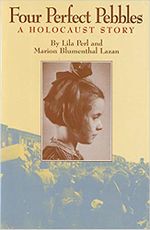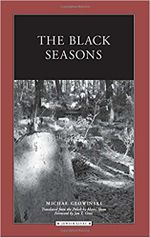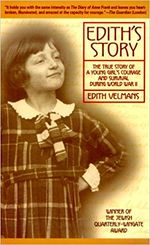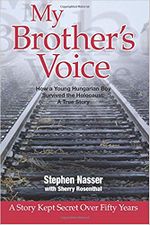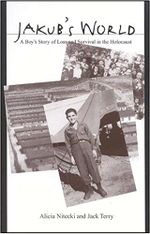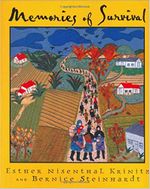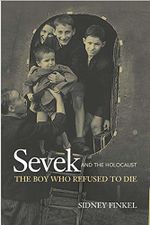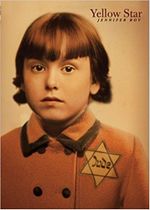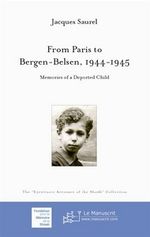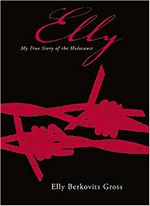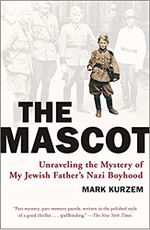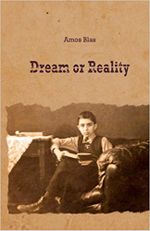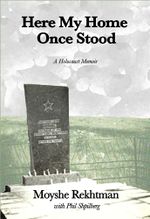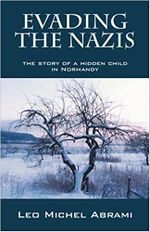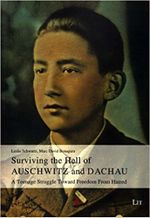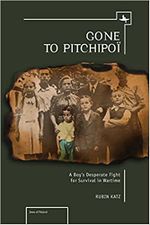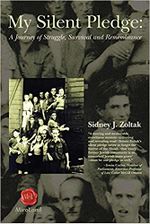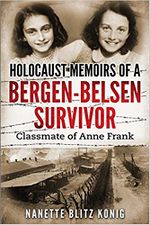Category:Holocaust Children's Memoirs (subject)
Holocaust Children's Memoirs
- Holocaust Children -- Holocaust Children's Biographies -- Holocaust Children's Diaries -- Holocaust Children's Movies
1950s
1956
- Elie Wiesel (M / Romania, 1928-2016). און די וועלט האָט געשוויגן / Un di Velt Hot Geshvign ["And the World Remained Silent"] <Yiddish> (Buenos Aires: Central Union of Polish Jews in Argentina, 1956). Revised French ed. La Nuit (Paris: Les Éditions de Minuit, 1960). English ed. The Night, trans. Stella Rodway (New York: Hill & Wang; and London: MacGibbon & Kee, 1960). International bestseller. Translated in more than 20 languages.
1958
- Thomas Geve / Stefan Cohn (M / Germany, 1929). Youth in Chains (Jerusalem : R. Mass, 1958).
1959
- Edith Bruck / Edith Steinschreiber (F / Hungary, 1932). Chi ti ama così <Italian> (Milan: Lerici, 1959). English ed.: Who Loves You Like This, trans. Thomas Kelso (Philadelphia, Pa. : Paul Dry Books, 2001).
1960s
1967
- Halina Birenbaum (F / Poland, 1929), Nadzieja umiera ostatnia (1967). English ed. Hope Is the Last to Die (1994)
- Jack Kuper (M / Poland, 1932). Child of the Holocaust (London: Routledge & K. Paul, 1967).
- Beni Virtzberg (M / Germany, Poland, 1928-1968). Milayl Habedolah Ve'ad Laylot Hakrav [From Kristallnacht to the Nights of Battle] (Jerusalem: Masada Press, 1967). English ed. From Death to Battle: Auschwitz Survivor and Palmach Fighter (Jerusalem: Yad Vashem, 2017).
1970s
1972
- Johanna Reiss (F / Netherlands, 1932). The Upstairs Room (1972). Juvenile audience.
1973
- Joseph Joffo (M / France, 1931-2018).Un Sac de billes <French> (1973). English trans. A Bag of Marbles (Boston: Houghton Mifflin, 1974).
1975
- Imre Kertész (Hungary, 1929-2016). Sorstalanság <Hungarian> (1975). English trans. Fateless / Fatelessness (1992).
1977
- Sara Zyskind / Sara Rachela Plagier (F / Poland, 1927-1995). העטרה שאבדה : בגיטו לודז׳ ובמחנות / ha-ʻAṭarah she-avdah: be-geṭo Lodz' uva-maḥanot <Hebrew> (Tel Aviv: Bet loḥame ha-getaʼot ṿe-hotsaʼat ha-Ḳibuts ha-meʼuḥad, 1977). English trans. Stolen Years (Minneapolis, MN: Lerner Publications Co., 1981)
1978
- Saul Friedländer (M / France, 1932). Quand vient le souvenir <French> (1978). English ed. When Memory Comes (New York : Farrar, Straus, Giroux, 1979). Also translated into German, Hebrew, Spanish, and Italian.
- Jona Oberski (M / Netherlands, 1938). Kinderjaren <Dutch> (1978). English trans. Childhood. Garden City, NY: Doubleday, 1983 / repr. New York, NY: Penguin Books, 2014. Translated into English, French, German, Italian, Spanish
- John G. Stoessinger (M / Austria, 1927-2017). Night Journey: A Story of Survival and Deliverance (1978). New ed. "From Holocaust to Harvard"
1979
- Samuel Pisar (M / Poland, 1929-2015). Le sang de l'espoir <French> (Paris: Laffont, 1979). English trans. Of Blood and Hope (Boston : Little, Brown, 1980).
1980s
1980
- Ben Edelbaum (M / Poland, 1928-1990). Growing up in the Holocaust (Kansas City, MO : Edelbaum, 1980). Adapted by Margaret Baldwin for juvenile audience: The Boys Who Saved the Children (New York: J. Messner, 1981).
- Livia Bitton-Jackson / Elli L. Friedmann (F / Czechia). Elli : Coming of Age in the Holocaust (New York : Times Books, 1980). In 1997 the author wrote a version of her autobiography for juvenile audience. I Have Lived a Thousand Years: Growing Up in the Holocaust (New York, NY: Simon & Schuster Books for Young Readers, 1997).
1981
- Uri Orlev (M / Poland, 1931). האי ברחוב הציפורי <Hebrew> (Jerusalem: 1981) is a semi-autobiographical novel written by Holocaust survivor Uri Orlev (b.1931). English trans. The Island on Bird Street (Boston, MA: Houghton Mifflin, 1984).
- Aranka Siegal (F / Hungary, 1930). Upon the Head of the Goat: A Childhood in Hungary (New York, NY: Farrar Straus Giroux, 1981).
1983
- Frida Weinstein / Frida Scheps (F / France, 1936). J'habitais rue des Jardins Saint-Paul (Paris: Balland, 1983). English ed. A Hidden Childhood, 1942-1945 (New York : Hill and Wang, 1985).
1985
- Marek Herman (M / Poland, 1927). From the Alps to the Red sea (Israel:Ghetto Fighters' Museum, 1985). Repr. 2020.
1986
- Inge Auerbacher (F / Germany, 1934). I Am a Star: Child of the Holocaust (New York, NY: Prentice-Hall Books for Young Readers, 1986) is the memoir written by Holocaust survivor Inge Auerbacher (b.1934).
- Janina Bauman (F / Poland, 1928). Winter in the Morning: a young girl's life in the Warsaw ghetto and beyond (1986).
1986
- Ruth Minsky Sender / Riva Minska (F / Poland, 1926). The Cage (1986).
1988
- Alicia Appleman-Jurman (F / Poland, 1930-2017). Alicia (Toronto, and New York : Bantam Books, 1988).
- Dov Freiberg (Poland, 1927-2008). To Survive Sobibor (1988).
- Eva Schloss (F / Netherlands, 1929). Eva's Story: A Survivor's Tale (New York : St. Martin's Press, 1988).
1989
- Yehuda Nir (M / Poland, 1930-2014).The Lost Childhood (San Diego : Harcourt Brace Jovanovich, 1989) is the memoir written by Holocaust survivor Yehuda Nir (1930-2014).
1990s
1991
La Petite Fille Du Vel d'Hiv (1991) is a memoir written by Holocaust survivor Annette Muller.
KEYWORDS: <France>
1992
- Ruth Klüger (F / Austria, 1931). Weiter Leben: eine Jugend <German> (1992). English trans. Still Alive: A Holocaust Girlhood Remembered (New York, NY: Feminist Press at the City University of New York, 2001)
1993
- Shlomo Breznitz (M / Slovakia, 1936). Sedot ha-zikaron (Tel Aviv : `Am `oved, 1993). English ed. Memory Fields: The Legacy of a Wartime Childhood in Czechoslovakia (New York: Knopf, 1993). Also translated into German.
1993
- Harry Goldman (M / Germany, 1931-1948). -- See Louis Goldman (1925-1996). Amici per la vita (Firenze : Ed. Sp44, 1993). English ed. Friends for Life: The Story of a Holocaust Survivor and His Rescuers (New York : Paulist Press, 2008)
1993
- Nelly S. Toll (F / Poland, 1935). Behind the Secret Window: A Memoir of a Hidden Childhood during World War Two (New York: Dial Books, 1993).
1994
- Schoschana Rabinovici (F / Lithuania, 1932-2019). Dank meiner Mutter <German> (Frankfurt am Main: Alibaba, 1994). English trans. Thanks to My Mother (New York, NY: Puffin, 1998).
1994
- Ruth Kapp Hartz (F / Frence, 1937). Your Name Is Renée: Ruth Kapp Hartz's Story as a Hidden Child in Nazi-Occupied France (New York: Oxford University Press, 1994), by Stacy Cretzmeyer.
1995
- Miriam Akavia (F / Poland, 1927-2015). An End to Childhood (1995).
1995
- Solly Ganor (M / Lithuania, 1928). Light One Candle: A Survivor's Tale from Lithuania to Jerusalem (1995) is a memoir written by Holocaust survivor Solly Ganor (b.1928).
1996
- Ruth David (F / Germany, 1929). Ein Kind unserer Zeit (Frankfurt am Main: dipa-Verl., 1996). English ed. Child of Our Time: A Young Girl's Flight from the Holocaust (London: Tauris, 2002).
1996
Four Perfect Pebbles: A Holocaust Story (New York: Greenwillow Books, 1996) is a memoir written by Holocaust survivor Marion Blumenthal Lazan, with Lila Perl.
KEYWORDS: <Westerbork> <Bergen-Belsen> <Troebitz Train>
"Marion Blumenthal Lazan’s unforgettable and acclaimed memoir recalls the devastating years that shaped her childhood. Following Hitler’s rise to power, the Blumenthal family—father, mother, Marion, and her brother, Albert—were trapped in Nazi Germany. They managed eventually to get to Holland, but soon thereafter it was occupied by the Nazis. For the next six and a half years the Blumenthals were forced to live in refugee, transit, and prison camps, including Westerbork in Holland and Bergen-Belsen in Germany, before finally making it to the United States. Their story is one of horror and hardship, but it is also a story of courage, hope, and the will to survive."--Publisher description.
Marion Blumenthal Lazan (b.1934) was born in Germany, moved to the Netherlands and experienced the Nazi concentration camps.
1997
- David Faber (M / Poland, 1928-2015). Because of Romek: A Holocaust Survivor's Memoir (El Cajon, CA: Granite Hills Press, 1997). Also published in German.
1997
- Magda Denes (F / Hungary, 1934-1996). Castles Burning: A Child's Life in War (New York : W.W. Norton & Co., 1997) is the memoir written by Holocaust survivor Magda Denes (1934-1996). Also published in German, Czech, Hungaria & Spanish.
1997
- Miriam Winter (F / Poland, 1933-2014). Trains: A Memoir of a Hidden Childhood During and After World War 2 (Jackson, MI: Kelton Press, 1997).
1998
Czarne sezony (1998) is the memoir written by Holocaust survivor Michal Glowinski (b.1934).
English ed. The Black Seasons (Evanston, Il: Northwestern University Press, 2005)
KEYWORDS: <Poland> <Warsaw Ghetto> <Hidden Children> <Christian Orphanage>
"A mosaic of memories from a childhood in the Warsaw Ghetto and a life in hiding on the other side of the wall ... When six-year-old Michal Glowinski first heard the adults around him speak of the ghetto, he understood only that the word was connected with moving-and conjured up a fantastical image of a many-storied carriage pulled through the streets by some umpteen horses. He was soon to learn that the ghetto was something else entirely. A half-century later, Glowinski, now an eminent Polish literary scholar, leads us haltingly into Nazi-occupied Poland. Scrupulously attentive to the distance between a child's experience and an adult's reflection, Glowinski revisits the images and episodes of his childhood: the emaciated violinist playing a Mendelssohn concerto on the ghetto streets; his game of chess with a Polish blackmailer threatening to deliver him to the Gestapo; and his eventual rescue by Catholic nuns in an impoverished, distant convent. In language at once spare and eloquent, Glowinski explores the horror of those years, the fragility of existence, and the fragmented nature of memory itself."--Publisher description.
Michal Glowinski (Poland, 1934), Holocaust survivor -- Michal Glowinski is among the most renowned literary scholars in Poland and the author of numerous works of literary criticism, history, and theory. He is a long-time professor at the Institute of Literary Studies of the Polish Academy of Sciences in Warsaw.
1998
- Arek Hersh (M / Poland, 1928). A Detail of History: The Harrowing True Story of a Boy Who Survived the Nazi Holocaust (Laxton : Beth Shalom, 1998). Repr. Malmesbury, UK: Apostrophe Books, 2015.
1998
- Anita Lobel (F / Poland, 1934). No Pretty Pictures: A Child of War (New York, NY: Greenwillow Books, 1998).
1999
- Aharon Appelfeld (M / Poland, 1932-2018). סיפור חיים <Hebrew> (Jerusalem: Keter, 1999). English ed. The Story of a Life (New York: Schocken Books, 2004).
1999
- Shalom Eilati (M / Lithuania, 1933). לחצות את הנהר <Hebrew> (Jerusalem: Yad Vashem, 1999). English ed. Crossing the River (Tuscaloosa : University of Alabama Press, 2008).
2000s
2000
- Naomi Samson (F / Poland, 1933). Hide: A Child's View of the Holocaust (Lincoln, NE: University of Nebraska Press, 2000).
2000
- Roma Ligocka (b.1938). Das Mädchen im roten Mantel (München: Droemer, 2000). English edition: The Girl in the Red Coat (New York : St. Martin's Press, 2002). Also translated into Polish (2001)
2001
- Andrew S. Grove / Andris Grof (M / Hungary, 1936-2016). Swimming Across (New York, NY: Warner Books, 2001).
2001
- Jack Mandelbaum (M / Poland, 1927). Surviving Hitler: A Boy in the Nazi Death Camps (New York: HarperCollins Publishers, 2001), by Andrea Warren <juvenile audience>.
2001
Edith's Story The True Story of a Young Girl's Courage and Survival During World War II (New York : Bantam, 2001) is a memoir of Holocaust survivor Edith Velmans (b.1925)
KEYWORDS: <Netherlands> <Hidden Children>
"In 1940, while the Germans occupied Holland, fourteen-year-old Edith van Hessen was filling her diary with the intimate, carefree details of a typical teenager's life — thoughts about boys, school, her family, her friends, her future. By 1942, as Edith was contemplating her first kiss, the Germans had begun to escalate their war against the Jews. Soon this bright, fun-loving girl was grappling with one of the most unfathomable events in human history. Edith's family — assimilated Dutch Jews — were caught in the cross fire of the Holocaust, and Edith began a bitter struggle to survive ... In this extraordinary work, Edith Velmans weaves together revealing entries from her diaries with reminiscences and letters smuggled between family members during the occupation. Edith's Story stands as a profoundly important addition to the literature of the Holocaust, documenting one girl's grief, loss, courage, and ultimate triumph over devastating tyranny and despair. For as Edith is hidden in plain sight by a Christian family, we witness how a young woman must deny, bargain with, and finally face the horrors of war — and how, confronting evil as a child, Edith survives to become an extraordinary woman."--Publisher description.
Edith Velmans (b.1925)
2002
- Sophia Richman (F / Poland, 1941). A Wolf in the Attic: The Legacy of a Hidden Child of the Holocaust (New York: Haworth Press, 2002).
2003
My Brother's Voice: How a Young Hungarian Boy Survived the Holocaust (Las Vegas, Nev. : Stephens Press, 2003) is a memoir of Holocaust survivor Stephen Nasser (b.1931)
KEYWORDS: <Hungary> <Auschwitz>
"Stephen Nasser was 13 years old when the Nazis sent him and his family to Auschwitz. Stephen tells his story in the direct and optimistic language of a young boy ... Stephen Nasser somehow dug deep within his soul to survive the brutal and inhumane treatment his captors inflicted on the Jews. He was the only one of his family to survive--but the memory of his brother's dying words compelled him to live. Stephen's account of the Holocaust, told in the refreshingly direct and optimistic language of a young boy, appeals to both younger audiences and his contemporaries. Written in a straightforward, narrative style, Nasser avoids the cloying or maudlin language that characterizes some stories of the Holocaust. Perhaps it's for that reason readers will find his book one they won't forget--and one they recommend to others as a "must read."--Publisher description.
Stephen Nasser (b.1931) was born in 1931. He and his family were forced into a ghetto in 1943. They were transported to Auschwitz-Birkenau shortly after, where Nasser witnessed the murder of several relatives. He was liberated from a death train on April 30, 1945 by General Patton’s Third Army. After the war, he moved to the United States.
2004
- Ursula Bacon (F / Germany, 1927). Shanghai Diary: A Young Girl's Journey from Hitler's Hate to War-Torn China (Milwaukie, Or. : M Press, 2004).
2005
- Isaac Millman (M / France, 1933). Hidden Child (New York, NY: Farrar, Straus and Giroux, 2005).
2005
Jakub's World: A Boy's Story of Loss and Survival in the Holocaust (Albany : State University of New York Press, 2005) is a memoir written by Holocaust survivor Jack Terry (b.1930), with writer Alicia Nitecki.
KEYWORDS: <Poland> <Flossenburg>
"When German troops come to the small village of Belzyce, Poland, in 1939, nine-year-old Jakub Szabmacher's world is forever changed. At first the humiliations inflicted by the Germans seem small, but the conditions worsen until eventually Jakub's family and much of his village are murdered, and he is sent to various concentration camps in Poland and Germany, where he struggles to survive the terrible conditions of camp life. Finally liberated in 1945 from the concentration camp in Flossenburg, Germany, Jakub is befriended by American troops and with their help brought to the United States, where he takes the name Jack Terry. Coauthor Alicia Nitecki, whose grandfather was also imprisoned at Flossenburg, uses Terry's personal memories to tell young Jakub's story, as well as unpublished memoirs, private letters, and interviews with former inmates of the Flossenburg concentration camp and the townspeople of Belzyce and Flossenburg. Part history, part autobiography, Jakub's World offers an anguished young boy's perspective on the Holocaust."--Publisher description.
Jack Terry (Jakub Szabmacher; b.1930) was born in Poland.
2005
- Edith Milton / Edith Cohn (F / Germany, 1932). The Tiger in the Attic: Memories of the Kindertransport and Growing Up English (Chicago, IL: University of Chicago Press, 2005).
2005
Memories of survival (New York: Hyperion books for Children, 2005) is a memoir written by Holocaust survivor Esther Nisenthal Krinitz (1927-2001).
KEYWORDS: <Poland> <Hidden Children>
"A story of surviving the Holocaust in Poland, illustrated in a collection of embroidered panels, and told in the survivor's own words ... Esther Nisenthal Krinitz was a survivor of the Holocaust in Poland. At the age of 15, in October 1942, having lived under Nazi occupation for three years, she and her sister decided to separate from their family and disguise themselves as Catholic farmhands. Esther never saw her family again. In 1977, at the age of 50, having worked throughout her life as a dressmaker, she began hand-stitching embroidered fabric panels as a way of remembering, healing and sharing her childhood stories. She went on to create 36 pieces chronicling the key moments of her childhood story. Esther passed away in 2001 but lives on through her unforgettable tapestries of survival. Her daughter, Bernice Steinhardt, adds insightful narrative to each panel as she recounts her own recollections of the stories her mother shared with her."--Publisher description.
Esther Nisenthal Krinitz (Poland, 1927-2001)
2006
Sevek and the Holocaust: The Boy Who Refused to Die (Matteson, Ill. : Sidney Finkel, 2006) is the memoir written by Holocaust survivor Sidney Finkel (Sevek Finkel; b.1931).
KEYWORDS: <Poland> <Treblinka> <Buchenwald>
"Sidney “Sevek” Finkel is the author of Sevek and the Holocaust, The Boy Who Refused to Die. This Holocaust memoir is told from the perspective of eight-year-old Sevek, capturing the emotions of a boy who loses his home, his family and ultimately his humanity by the time he reaches the age of fourteen. He lived in a cramped and disease-ridden ghetto, saw his family murdered, endured the horrors of the Treblinka death camp, ate grass for survival in the final days before reaching freedom, and, finally, resumed his education in a foreign country after a six-year lapse. This 2nd Edition includes a new chapter about Sevek's return to Buchenwald 66 years after liberation, as well as new-found information learned during this visit. This book has been used as part of the Holocaust curriculum in hundreds of middle schools across the country, and Finkel has shared his story with thousands of students, relaying a message of tolerance, hope and love. Sevek and the Holocaust, The Boy Who Refused to Die received positive reviews from the Kirkus Review and Writer’s Digest. Sidney Finkel received the Philip K Weiss Award for Storytelling for Peace and Human Rights in 2013."--Publisher description.
Sidney Finkel (b.1931)
2006
Yellow Star (Tarrytown, NY : Marshall Cavendish,) is the biography of Holocaust survivor Syvia Perlmutter Rozines, narrated by her niece Jennifer Rozines Roy.
KEYWORDS: <Poland> <Lodz Ghetto>
""In 1945 the war ended. The Germans surrendered, and the ghetto was liberated. Out of over a quarter of a million people, about 800 walked out of the ghetto. Of those who survived, only twelve were children. I was one of the twelve." For more than fifty years after the war, Syvia, like many Holocaust survivors, did not talk about her experiences in the Lodz ghetto in Poland. She buried her past in order to move forward. But finally she decided it was time to share her story, and so she told it to her niece, who has re-told it here using free verse inspired by her aunt. This is the true story of Syvia Perlmutter—a story of courage, heartbreak, and finally survival despite the terrible circumstances in which she grew up. A timeline, historical notes, and an author's note are included."--Publisher description.
Syvia Perlmutter Rozines was born in Lodz in 1935 to a Jewish family. Under Nazi occupation, the family was forced to live in the Lodz ghetto. When the Jewish children of Lodz were sent to die at Chelmno, Syvia's family smuggled the children from cellar to cellar. When Lodz was liberated on January 19, 1945, Syvia, her older sister Dora, and a younger cousin, Isaac, were three of only twelve children who survived in the ghetto. After the war, the family moved to the United States. More than 50 years after the events described in the book, Perlmutter Rozines began telling her story to family members.
2006
De Drancy à Bergen-Belsen, 1944-45 <French> (Paris: Le Manuscrit, 2006) is the memoir written by Holocaust survivor Jacques Saurel (b.1933).
English ed. From Paris to Bergen-Belsen, 1944-1945: Memories of a Deported Child (Paris : Le Manuscrit : Fondation pour la mémoire de la Shoah, 2010).
KEYWORDS: <France> <Drancy> <Bergen-Belsen> <Troebitz Train>
"Born in 1933, Jacques Saurel might well have known the fate of so many children of Jewish parents who emigrated from Poland between the wars: Auschwitz and the gas chamber. He owed it to his father that he initially had no problems with the authorities. As a volunteer for military service and then a prisoner of war, his father protected Jacques and his family under the Geneva Convention. But the Nazis were looking for hostages to deport. Thus, in early February 1944, Jacques, his older sister (the younger one was in hiding) and his little brother were detained with their mother for three months in the Drancy internment camp, before being deported to the "Star Camp", Bergen-Belsen. It was in turn to their mother that the children owed their survival. If they enjoyed "privileged" conditions because the Nazis wanted to use her as a bargaining chip, these children would never have survived without the moral support and sacrifices of their mother. All the more so because living conditions, already harsh, worsened from the autumn of 1944 with the influx of survivors evacuated from the camps further east. With its organization falling apart, Bergen-Belsen became a veritable death camp riddled with famine and epidemic disease. Jacques and his family regained their freedom after experiencing in April 1945 the agonies of the refugee "Ghost Train" on which half the 2,000 Jews evacuated from the Star Camp lost their lives. Jacques and his sister were stricken with typhus. They were reunited with their father at Paris´s repatriation centre in the Hotel Lutetia on June 23, 1945. Although they survived, the same could not be said for other members of the family: no trace of those living in Poland; in France, Jacques lost his paternal grandparents, three uncles, two aunts and six cousins. From this confrontation with horror at such a young age, escaping he still does not know how, Jacques conceived one great passion: life itself."--Publisher description.
Jacques Saurel (France, 1933), Holocaust survivor.
2006
- Ela Weissberger (F / Czechia, 1930-2018). The Cat with the Yellow Star: Coming of Age in Terezin (New York, NY: Holiday House, 2006).
2007
- Thomas Buergenthal (M / Slovakia, Poland, 1934). A Lucky Child: A Memoir of Surviving Auschwitz as a Young Boy (2007).
2007
Elly: My True Story Of The Holocaust (New York: Scholastic, 2007) is the memoir written by Holocaust survivor Elly Gross (b.1929).
KEYWORDS:
"Relates how the author was torn from her happy home and sent to Birkenau by the Nazis, describing how she worked long hours and fought for survival before being set free at the end of the war and beginning a new life in America ... Told in short, gripping chapters, this is an unforgettable true story of survival. The author was featured in Steven Spielberg's Survivors of the Shoah Visual History Foundation ... At just 15, her mother, and brother were taken from their Romanian town to the Auschwitz-II/Birkenau concentration camp. When they arrived at Auschwitz, a soldier waved Elly to the right; her mother and brother to the left. She never saw her family alive again. Thanks to a series of miracles, Elly survived the Holocaust. Today she is dedicated to keeping alive the stories of those who did not. Elly appeared on CBS's 60 Minutes for her involvement in bringing an important lawsuit against Volkswagen, whose German factory used her and other Jews as slave laborers."--Publisher description.
Elly Gross (b.1929).
2007
The Mascot: Unraveling the Mystery of My Jewish Father's Nazi Boyhood (New York : Viking, 2007) is the story of Holocaust survivor Alex Kurzem (b.1936), narrated by his son Mark Kurzem.
KEYWORDS: <Latvia> <Errand Boys>
"When a Nazi death squad massacred his mother and fellow villagers, five-year-old Alex Kurzem escaped, hiding in the freezing Russian forest until he was picked up by a group of Latvian SS soldiers. Alex was able to hide his Jewish identity and win over the soldiers, becoming their mascot and an honorary "corporal" in the SS with his own uniform. But what began as a desperate bid for survival became a performance that delighted the highest ranks of the Nazi elite. And so a young Jewish boy ended up starring in a Nazi propaganda film ... After sixty-three years of silence, Alex revealed his terrible secret to his son Mark. With his son's help, Alex retraced his past in search of answers and vindication. His story is at once a terrifying account of survival and its psychological cost as well as a brutally honest examination of identity, complicity, and memory."--Publisher description.
Alex Kurzem (b.1936)
2008
חלום או מציאות <Hebrew> (Tel-Aviv: Ḥalonot, 2008) is the memoir written by Holocaust survivor Amos Blas (b.1935).
English ed. Dream or Reality (Tel-Aviv: Contento de Semrik, 2011).
KEYWORDS: <Poland> <Warsaw Ghetto> <Hidden Children>
"Amos Blas was three years old when Nazi German forces occupied Poland. In his book, the author returns to the horror of those days, to his experiences in the infamous Warsaw ghetto, and later hidden with a fake identity as a Christian boy in a remote Polish village. The author moves beyond the war years, and relates the influences of the Holocaust on the course of his life, including the crushing effects on his professional life, intimate relationship, and religious faith. It is the story of how an illiterate boy of twelve, suffering post-traumatic stress, battled his demons, worked diligently in his studies, received a doctorate in engineering, and became a professor. By chance, the author meets a family member who, like him, also managed to survive the Holocaust and built his life in a distant land. The book delves into this special union that only took place when they were both already pensioners, and grandfathers to numerous grandchildren. Dream or Reality is built on the line between reality and imagination, between truth and hallucination. It also stands as a metaphor to the natural human tendency to disbelieve that such horrific acts could possibly happen. Yet World War II proves to humanity that even the seemingly impossible can turn into reality. "--Publisher description.
Amos Blas (Poland, 1935), Holocaust survivor -- Amos Blas was a child when the Holocaust began in Europe. He survived the Warsaw ghetto. In 1947 he moved to Israel. There he received a doctorate in engineering, worked for thirty-five years in the defense industry, and taught at prominent academic institutions. Since 2005, he has published five books. The book Dreams and Reality is his second published book. The book received a warm review by Shimon Peres, the president of the state of Israel.
2008
- Krystyna Chiger (F / Poland, 1935). The Girl in the Green Sweater (New York, NY: St. Martin's Griffin, 2008). -- See also Robert Marshall, In the Sewers of Lvov: A Heroic Story of Survival from the Holocaust, New York: Macmillan Publishing Company.
2008
- Clara Kramer (F / Poland, 1927-2018). Clara's War: One Girl's Story of Survival (London: Ebury Press, and New York, NY: Ecco Press, 2008).
2008
Here My Home Once Stood (San Rafael, CA : Fourth Generation Pub., 2008) is the memoir written by Holocaust survivor Moyshe Rekhtman (b.1927).
KEYWORDS: <Ukraine> <Hidden Children> <Street Children>
"As a fourteen-year-old Jewish boy who had rarely ventured outside his small, remote village, Moyshe Rekhtman may seem an unlikely escape artist. But his iron will and quick wit allowed him to survive when all seemed lost. Staging escapes from death camps and avoiding Nazi pursuit through the frozen Ukrainian countryside-all while facing the loss of his family, famine, constant threat of capture, torture, and execution - would be a monumental task for the strongest of men. Despite his mild manners, emaciated body, and poor vision, he evaded the death squads in Nazi-occupied Ukraine for four years. Moyshe's Holocaust memoir is a remarkable example of human fortitude during a time when many welcomed an end to their suffering."--Publisher description.
Moyshe Rekhtman (b.1927)
2009
- Eva Mozes Kor (F / 1934-2019). Surviving the Angel of Death: The Story of a Mengele Twin in Auschwitz (Terre Haute, IN: Tanglewood Pub., 2009).
2009
Sono stato un numero <Italian> (Firenze: La Giuntina, 2009) is the memoir written by Holocaust survivor Alberto Sed (1928-2019).
KEYWORDS: <Italy> <Auschwitz> <Mittelbau-Dora>
2009
Evading the Nazis: The Story of a Hidden Child in Normandy (Denver: Outskirts Press, 2009) is a memoir written by Holocaust survivor Leo Michel Abrami (France, 1931).
KEYWORDS : <France> <Hidden Children> / <United States>
"Evading the Nazis tells the story of a Jewish boy who lived in German-occupied France during World War II and the period that followed the liberation of Europe by the Allies. The author recounts some of the dangerous situations he faced during these years and how he eventually went into hiding on an isolated farm in Normandy where he stayed until the end of the war. In the years which followed the liberation, he entered a rabbinical seminary and he became a rabbi in the United States. The account is interspersed with vivid descriptions of how French people reacted to the presence of a foreign army in their country and how righteous individuals took upon themselves to save Jews from persecution, often at the risk of their lives.--Publisher description.
Leo Michel Abrami (France, 1931), Holocaust survivor -- Leo Michel Abrami was born in Paris, France, on Nov 10, 1931. He lived with his mother, brother, and grandmother. After the German army invaded France, Leo's mother thought it would be best if he moved to Evron outside of Normandy. There Leo remained hidden for two years before the Allied powers liberated France. After the war was over, Leo continued his education where he became a cantor. He worked in Geneva, Switzerland before traveling to the United States, where he attended the Hebrew Union College in Cincinnati and became an ordained rabbi.
2010s
2010
Durch die Hölle von Auschwitz und Dachau: ein Junge erkämpft sein Uberleben (Zürich: Lit, 2010) is the memoir written by Holocaust survivor Leslie Schwartz (b.1930).
English ed. Surviving the Hell of Auschwitz and Dachau: A Teenage Struggle Toward Freedom from Hatred (Zürich: Lit, 2013).
KEYWORDS: <Hungary> <Auschwitz> <Dachau>
"Born in Hungary in 1930, Leslie Schwartz was a teenage survivor of the horrors of Auschwitz and Dachau who lost his entire immediate family in the Holocaust. His lifelong search for wholeness has led him back to Germany where his dream now is to leave a legacy of healing and conflict resolution. This book documents Leslie's experiences as a survivor of the Holocaust. (In 2013, Schwartz was awarded Germany's highest civilian honor, the Federal Cross of Merit of the Federal Republic of Germany.) (Series: Anpassung - Selbstbehauptung - Widerstand - Vol. 35)."--Publisher description.
Leslie Schwartz (Hungary, 1930), Holocaust survivor
2011
- Yisrael Meir Lau (M / Poland, 1937). Out of the Depths: The Story of a Child of Buchenwald Who Returned Home at Last (New York: Sterling Pub.: In conjunction with OU Press, 2011).
2011
- Tomi Reichental (M / Slovakia, 1935). I Was a Boy in Belsen (Dublin [Ireland]: O'Brien, 2011).
2012
Gone to Pitchipoï : A Boy's Desperate Fight for Survival in Wartime (Boston : Academic Studies Press, 2012) is a memoir written by Holocaust survivor Rubin Katz (b.1931).
KEYWORDS: <Poland> <Hidden Children> <Street Children> -- <Lublin Orphanage>
"Gone to Pitchipoi is the true and remarkable story of one Jewish boy's constant struggle for survival during the Holocaust in wartime Poland. Rubin Katz had just turned eight years old when the Second World War began and the outbreak of hostilities shattered his secure and idyllic childhood ... Katz vividly recalls his experience growing up in the turmoil of WWII, and his extraordinary escape from the constant threats of Nazi occupied Poland. Born in 1931 in the picturesque countryside of Ostrowiec Swietokrzyskie, wherein more than a third of the population was Jewish, Katz experienced a constant juxtaposition of traditional ways of life with the tragedies of those years. Deemed unfit for labor camps, Katz was marked for certain death and forced to live on the run in a daily quest for food, shelter, and friendship. He eventually reunited with his sister, Fela, together encountering a series of narrow escapes and forging on to see the day of liberation. This book is a major contribution to our understanding of the fate of Jews in small Polish towns during the Second World War."--Publisher description.
Rubin Katz (Poland, 1931), Holocaust survivor
2012
- Estelle Laughlin (F / Poland, 1929). Transcending Darkness: A Girl's Journey Out of the Holocaust (Lubbock, TX: Texas Tech University Press, 2012).
2013
- Leon Leyson (M / Poland, 1929-2013). The Boy on the Wooden Box: How the Impossible Became Possible... on Schindler's List (New York, NY: Atheneum Books for Young Readers, 2013) is the memoir written by Holocaust survivor Leon Leyson (1929-2013).
- Felix Weinberg (M / Czechia, 1928-2012). Boy 30529: A Memoir (London & New York: Verso, 2013).
2013
My Silent Pledge: A Journey of Struggle, Survival and Remembrance (2013) is the memoir written by Holocaust survivor Sydney Zoltak (1931).
KEYWORDS: <Poland> <Hidden Children>
"A child survivor, a child of survivors and a grandchild of a survivor, Sidney Zoltak is all these things. His story about a family that struggled and endured, the generosity of those who saved them against all odds, and a vow never to forget is a remarkable journey through the Holocaust into a rich and full life. At eight, Sidney loses a middle class home and goes from the slow death of the ghetto into the terror of hiding in forests, barns and finally, a hole in the ground provided by a Polish farm family. But when war ends, there is no going back. We follow the Zoltak family, amazingly intact, as they make their way to Italy where young Sidney encounters a generosity of spirit that helps to heal war's wounds and prepares him for life in Canada. Sidney Zoltak's chronicle is a lesson in the importance of honouring your story for the generations to come."--Publisher description.
Sydney Zoltak (Poland, 1931), Holocaust survivor
2015
Eu Sobrevivi ao Holocausto (Universo dos Livros, 2015) is the memoir written by Holocaust survivor Nanette Blitz Konig (b.1929).
English ed. Holocaust Memoirs of a Bergen-Belsen Survivor & Classmate of Anne Frank (Amsterdam Publishers, 2018).
KEYWORDS: <Bergen-Belsen>
"A monument to the indestructible nature of the human spirit ... In these compelling Holocaust memoirs, Nanette Blitz Konig relates her amazing story of survival during the Second World War when she, together with her family and millions of other Jews, was imprisoned by the Nazis with a minimum chance of survival ... Nanette (b. 1929) was a class mate of Anne Frank in the Jewish Lyceum of Amsterdam. They met again in the Bergen-Belsen concentration camp shortly before Anne died. During these emotional encounters, Anne Frank told her how the Frank family hid in the annex, talked about their deportation, and her experience in Auschwitz, and about her plans with her diary after the war ... This honest WW2 story describes the hourly battle for survival under the brutal conditions in the camp imposed by the Nazi regime. It continues with her struggle to recover from the effects of starvation and tuberculosis after the war, and how she was gradually able to restart her life, marry and build a family."--Publisher description.
Nanette Blitz Konig (Netherlands, 1929), Holocaust survivor
2015
Nate Leipciger (M / Poland, 1928). The Weight of Freedom (Toronto: The Azrieli Foundation, 2015).
2017
- Michael Bornstein (M / Poland, 1940). Survivors Club: The True Story of a Very Young Prisoner of Auschwitz (New York, NY: Farrar Straus Giroux, 2017).
2019
- Rena Finder (F / Poland, 1929). My Survival: A Girl on Schindler's List (New York, NY: Scholastic Press, 2019).
2019
- Zuzana Růžičková (F / Chechia, 1927-2017)One Hundred Miracles: A Memoir of Music and Survival (London: Bloomsbury, 2019).
Collections of memoirs
1993
- Marks, Jane. The Hidden Children: The Secret Survivors of the Holocaust (New York: Ballantine Books, 1993)
"Presents the stories of twenty-three men and women who survived the Holocaust as children in hiding. Describes the extreme measures they or their families took to survive and how they coped under circumstances of great danger and sacrifice. Also examines their post-war experiences, exploring how they dealt with their own survival and rebuilt their lives."--Publisher description.
1993
- Greenfeld, Howard. The Hidden Children (New York: Ticknor & Fields, 1993)
"Relates the experiences of thirteen Jewish hidden children who survived, and came forward to tell their stories. Includes pictures, quotations, and a bibliography. Intended for younger readers."--Publisher description.
1994
- Rosenberg, Maxine B. Hiding to Survive: Stories of Jewish Children Rescued From the Holocaust (New York: Clarion Books, 1994)
"Provides fourteen first-person accounts of Jewish survivors who were hidden as children from the Nazis. Illuminates each survivor’s life before, during, and after the Holocaust. Includes a brief glossary and a bibliography. Created for juvenile readers."--Publisher description.
1994
- Stein, Andre. Hidden Children: Forgotten Survivors of the Holocaust (Toronto: Penguin Books, 1994)
"Compiles the first-person accounts of ten hidden children and relates their experiences during and after the war. Explores questions of identity, such as noticeable physical differences between adoptee and new parents and the postwar return to Jewish life."-- Publisher description.
1999
- Kustanowitz, Esther. The Hidden Children of the Holocaust: Teens Who Hid From the Nazis (New York: Rosen Publishing, 1999)
"Details, in their own words, the war-time experiences of Jewish teenagers hiding from the Nazis. Includes a bibliography, glossary and an extensive timeline of events. Intended for young adult readers."-- Publisher description.
2008
- Tománková, Magdalena. Ptaly se: proč? ukrývané děti vzpomínají = They asked: Why? Recollections of the Hidden Children (Pardubice: Batoš, 2008).
"Presents individual stories of hidden children from the Czech Republic. Includes endnotes. In both English and Czech."-- Publisher description.
2009
- Abrams, Judy, and Evi Blaikie, editors. Remember Us: A Collection of Memories from Hungarian Hidden Children of the Holocaust (Bloomington, IN: Authorhouse, 2009)
"Presents the accounts of thirty child survivors who escaped the fate of other Hungarian Jews by hiding during the Holocaust. Includes pictures and a glossary."-- Publisher description.
- [[Helga Weiss (1929)
- Ana Novac (b.1929)
- Renata Calverley (b.1937c) wrote Let Me Tell You a Story: One Girl's Escape from the Nazis.
Eva Schloss (1929-)
Pages in category "Holocaust Children's Memoirs (subject)"
The following 171 pages are in this category, out of 171 total.
1
- Ruth Minsky Sender / Riva Minska (F / Poland, 1926), Holocaust survivor
- Laura Varon (F / Rhodes, 1926), Holocaust survivor
- Matylda Weinfeld / Miriam Akavia (F / Poland, 1927-2015), Holocaust survivor
- Ursula Bacon (F / Germany, 1927)
- Bill Basch
- Tomasz Blatt (M / Poland, 1927-2015), Holocaust survivor
- Henri Borlant (M / France, 1927), Holocaust survivor
- Dov Freiberg (M / Poland, 1927-2008), Holocaust survivor
- Jack Gruener
- Marek Herman (M / Poland, Italy, 1927), Holocaust survivor
- Clara Kramer (F / Poland, 1927-2018), Holocaust survivor
- Henri Landwirth (M / Belgium, 1927-2018), Holocaust survivor
- Esther Nisenthal Krinitz
- Moyshe Rekhtman
- Zuzana Růžičková (Czechia, 1927-2017), Holocuast survivor
- John G. Stoessinger (M / Austria, 1927-2017), Holocaust survivor
- Chanania Teitel / Hannan Dekel (M / Poland, 1927-1993), Holocaust survivor
- Sara Zyskind / Sara Rachela Plagier (F / Poland, 1927-1995), Holocaust survivor
- Wolfgang Adler
- Eliezer Ayalon / Lejzor Herschenfin (M / Poland, 1927), Holocaust survivor
- George Brady / Jiří Brady (M / Czechia, 1928-2019), Holocaust survivor
- Ilse Charny (F / Austria, 1928), Holocaust survivor
- Vera Diament / Vera Gissing (F / Czechia, 1928), Holocaust survivor
- Gerhard Durlacher
- Ben Edelbaum (M / Poland, 1928-1990), Holocaust survivor
- David Faber (M / Poland, 1928-2015), Holocaust survivor
- Luigi Fleischmann (M / Italy, 1928), Holocaust survivor
- Roman Frister
- Solly Ganor (M / Lithuania, 1928), Holocaust survivor
- Petr Ginz (M / Czechia, 1928-1944), Holocaust victim
- Heinz Goldstein / Henry Gallant (M / Germany, 1928-2019), Holocaust survivor
- Arek Herszlikowicz / Arek Hersh (M / Poland, 1928), Holocaust survivor
- Hanna Kugler Weiss (F / Italy, 1928), Holocaust survivor
- Tom Lantos (M / Hungary, 1928-2008), Holocaust survivor
- Nate Leipciger (M / Poland, 1928), Holocaust survivor
- Marceline Loridan-Ivens / Marceline Rozenberg (F / France, 1928-2018), Holocaust survival
- Hanna Pankowsky / Hanna Davidson (F / Poland, 1928-2020), Holocaust survivor
- Gilberto Salmoni (M / Italy, 1928), Holocaust survivor
- Davide Schiffer (M / Italy, 1928-2020), Holocaust survivor
- Alberto Sed (M / Italy, 1928), Holocaust survivor
- Lore Segal / Lore Groszmann (F / Austria, 1928), Holocaust survivor
- Martin Spett (M / Poland, 1928-2019), Holocaust survivor
- Beni Virtzberg (M / Germany, Poland, 1928-1968), Holocaust survivor
- Felix Weinberg (M / Czechia, 1928-2012), Holocaust survivor
- Elie Wiesel (M / Romania, 1928-2016), Holocaust survivor
- Edith Balas
- Becky Behar (F / Turkey, Italy, 1929-2009), Holocaust survivor
- Andre Berkover
- Margit Buchhalter Feldman (F / Hungary, 1929-2020), Holocaust survivor
- Ruth David (F / Germany, 1929-2020), Holocaust survivor
- Cordelia Edvardson
- Rena Finder (Poland, 1929), Holocaust survivor
- Thomas Geve / Stefan Cohn (M / Germany, 1929), Holocaust survivor
- Elly Gross
- Samuel Hoffman / Martin Hoffman (M / Czechia, 1929-2018), Holocaust survivor
- Simon Jeruchim (M / France, 1929), Holocaust survivor
- Imre Kertész (M / Hungary, 1929-2016), Holocaust survivor
- Ilse Koehn
- Akiva Kohane (M / Poland, 1929), Holocaust survivor
- Estelle Laughlin / Estelle Wakszlak (F / Poland, 1929), Holocaust survivor
- Samuel Pisar (M / Poland, 1929-2015), Holocaust survivor
- Eva Schloss / Eva Geiringer (F / Netherlands, 1929), Holocaust survivor
- Judita Stern / Judith Sherman (F / Slovakia, 1929), Holocaust survivor
- Alicia Weinsberg / Alicja Fajnsztejn (F / Poland, 1929), Holocaust survivor
- Helga Weiss / Helga Hošková-Weissová (F / Czechia, 1929), Holocaust survivor
- Irene Zisblatt
- Janina David
- Cesare Moise Finzi (M / Italy, 1930), Holocaust survivor
- Michael Gruenbaum (M / Czechia, 1930)
- Bertrand Herz (France, 1930)
- Ingrid Kisliuk / Inge Scheer (F / Austria, 1930-2020), Holocaust survivor
- Michal Kraus (M / Czechia, 1930), Holocaust survivor
- Hans Helmut Michel (M / Germany, France, 1930-1944), Holocaust victim
- Sami Modiano (M / Rhodes, 1930), Holocaust survivor
- Yehuda Nir / Juliusz Gruenfeld (M / Poland, 1930-2014), Holocaust survivor
- Josef Perl (M / Slovakia, 1930), Holocaust survivor
- Helga Pollak-Kinsky (F / Austria, 1930), Holocaust survivor
- Aranka Siegal / Aranka Meizlik (F / Hungary, 1930), Holocaust survivor
- Marianne Spier-Donati (F / Germany, 1930), Holocaust survivor
- Regina Steinitz
- Ela Weissberger / Ela Stein (F / Czechia, 1930-2018), Holocaust survivor
- Esther Werkendam / Hetty Verolme (F / Netherlands, 1930), Holocaust survivor
- Leo Michel Abrami (M / France, 1931), Holocaust survivor
- Livia Bitton-Jackson / Elli L. Friedmann (F / Czechia, 1931), Holocaust survivor
- Hana Brady / Hanička Bradyová (F / Czechia, 1931-1944), Holocaust victim
- Sevek Finkelstein / Sidney Finkel (M / Poland, 1931), Holocaust survivor
- Simon Gronowski (M / Belgium, 1931), Holocaust survivor
- Suzanne Gross / Sarah Pertofsky (F / France, 1931), Holocaust survivor
- Renée Kann Silver (F / Germany, 1931), Holocaust survivor
- Ruth Klüger (Austria, 1931), Holocaust survivor
- Lia Levi (F / Italy, 1931), Holocaust survivor
- Stephen Nasser
- Emanuele Pacifici (M / Italy, 1931-2014), Holocaust survivor
- Mikulas Reichental (M / Slovakia, 1931), Holocaust survivor
- Josef Rosenbaum (M / Germany, 1931), Holocaust survivor
- Fatina Sed (F / Italy, 1931), Holocaust survivor
- Eva Slonim / Eva Weiss (F / Slovakia, 1931), Holocaust survivor
- Regina Teitel / Rivka Dekel (F / Poland, 1931), Holocaust survivor
- Romek Wajsman / Robbie Waisman (M / Poland, 1931), Holocaust survivor
- Samuel Max Werkendam (M / Netherlands, 1931-2005), Holocaust survivor
- Sidney Zoltak (M / Poland, 1931), Holocaust survivor
- Aharon Appelfeld (M / Poland, 1932-2018), Holocaust survivor
- Albert Bigielman (M / France, 1932), Holocaust survivor
- Edith Bruck / Edith Steinschreiber (F / Hungary, 1932)
- Krystyna Carmi (F / Poland, 1932)
- Henry Foner / Heinz Lichtwitz (M / Germany, 1932), Holocaust survivor
- Saul Friedländer (France, 1932), Holocaust survivor
- Pinchas Gutter (M / Poland, 1932), Holocaust survivor
- Jack Kuper / Jankele Kuperblum (M / Poland, 1932), Holocaust survivor
- Regine Miller (F / Belgium, 1932), Holocaust survivor
- Edith Milton / Edith Cohn (F / Germany, 1932), Holocaust survivor
- Schoschana Rabinovici / Suzanne Weksler (F / Lithuania, 1932-2019), Holocaust survivor
- Johanna Reiss (Netherlands, 1932), Holocaust survivor
- Cesare Rimini (M / Italy, 1932), Holocaust survivor
- Rolf Spier-Donati (M / Germany, 1932), Holocaust survivor
- Arie Tamir (M / Poland, 1932), Holocaust survivor
- Louis Begley / Ludwik Begleiter (M / Poland, 1933), Holocaust survivor
- Roman Ferber
- Annette Muller (F / France, 1933), Holocaust survivor
- Naomi Samson / Naomi Rosenberg (F / Poland, 1933), Holocaust survivor
- Arianna Szörényi (F / Italy, 1933), Holocaust survivor
- Zadok Jack Werkendam (M / Netherlands, 1933-2003), Holocaust survivor
- Aldo Zargani (M / Italy, 1933), Holocaust survivor
- Inge Auerbacher (F / Germany, 1934), Holocaust survivor
- Thomas Buergenthal (Poland, 1934), Holocaust survivor
- Magda Denes (F / Hungary, 1934-1996), Holocaust survivor
- Michal Glowinski
- Anita Kempler / Anita Lobel (F / Poland, 1934), Holocaust survivor
- Eva & Miriam Mozes (Romania, 1934)
- Ruth Barnett / Ruth Michaelis (F / Germany, 1935), Holocaust survivor
- Amos Blas
- Marcel Braitstein (M / Belgium, 1935), Holocaust survivor
- Krystyna Chiger / Kristine Keren (F / Poland, 1935), Holocaust survivor
- Erna Gorman (F / Poland, 1935), Holocaust survivor
- Peter Nachemstein / Peter Nash (M / Germany, 1935), Holocaust survivor
- Rena Quint
- Tomi Reichental (M / Slovakia, 1935), Holocaust survivor
- Sylvia Rozines
- Nelly S. Toll
- Jytte Bornstein (F / Denmark, 1936), Holocaust survivor
- Shlomo Breznitz
- Felicia Bryn (F / Poland, 1936-2014), Holocaust survivor
- Cesare Frustaci
- Andrew S. Grove (M / Hungary, 1936-2016), Holocaust survivor
- Renzo Modiano (M / Italy, 1936), Holocaust survivor
- Jurek Becker (M / Poland, 1937-1997), Holocaust survivor
- Ruth Kapp Hartz (F / France, 1937), Holocaust survivor
- Rachel Hyams / Rutka Greenspan (F / Poland, 1937), Holocaust survivor
- Eva Lavi / Ewa Ratz (F / Poland, 1937), Holocaust survivor
- Marian Marzynski / Marian Kuszner (M / Poland, 1937), Holocaust survivor
- Tova Friedman (F / Poland, 1938), Holocaust survivor
- Marione Ingram (F / Germany, 1938), Holocaust survivor
- Francine Lazarus (F / Belgium, 1938), Holocaust survivor
- Roma Ligocka / Roma Liebling (F / Poland, 1938), Holocaust survivor
- Trudie Strobel (F / Ukraine, 1938), Holocaust survivor
- Pawel Chiger (M / Poland, 1939), Holocaust survivor
- Rosemarie Koczy (F / Germany, 1939), Holocaust survivor
- Donatella Levi (F / Italy, 1939), Holocaust survivor
- Relli Robinson (F / Poland, 1939), Holocaust survivor
- Liliana Treves (F / Italy, 1939), Holocaust survivor
- Michael Bornstein (M / Poland, 1940), Holocaust survivor
- Sonja DuBois (F / Netherlands, 1940), Holocaust survivor
- Robert Finaly (M / France, 1941), Holocaust survivor
- Ib Katznelson (M / Denmark, 1941), Holocaust survivor
- Marguerite Lederman / Marguerite Mishkin (F / Belgium, 1941), Holocaust survivor
- Sophia Richman (F / Poland, 1941), Holocaust survivor
- Jasia Starkopf / Johanna Brainin (F / Poland, 1941-2017), Holocaust survivor
- Stefan Jerzy Zweig (M / Poland, 1941), Holocaust survivor
- Anita Epstein / Anita Kuenstler (F / Poland, 1942-2019), Holocaust survivor
- Julius Maslovat / Yidele Henechowicz (M / Poland, 1942), Holocaust survivor
- Joseph Polak (M / Netherlands, 1942), Holocaust survivor
Media in category "Holocaust Children's Memoirs (subject)"
This category contains only the following file.
- 1995 Zargani.jpg 319 × 499; 27 KB
